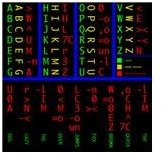Learn How to Secure Your Data with this Encryption Guide
What is Encryption?
Encryption is the art of making plain text unreadable for anyone except the intended recipients. The process of encryption converts information into a code using algorithms, and provides the decoding key to the intended recipients.
Encryption techniques found its way to computing from the military, where the use of ciphers was an established practice to prevent messages from falling into the hands of the enemy. The open nature of the Internet and the potential for intercepted communications make encryption a useful and often mandatory tool when transmitting private, confidential and sensitive information.
- What is Encryption?
- A Guide to Encryption for the Basic Computer User
- Understanding Encryption and Decryption
- Difference between Encryption and Cryptography
- An Overview of the International Data Encryption Algorithm (IDEA)
- Digital Signature vs. Email Encryption
- An Overview of Bulk Encryption
- What is Stored Data Encryption?
- Everything You Need to Know about Wireless Encryption Protocol
How to Encrypt
Encryption works in many ways, from using a simple codebook to advanced ciphers and algorithms of various strengths. The encryption can also take place at various levels: data, file, or drive, for example.
Choosing how to encrypt depends on many considerations such as the operating system in use, the system configuration, costs, alternatives available, security needed, and more. Most web browsers and websites can automatically encrypt sensitive data, such as when exchanging a credit card number, and the user does not have to perform any separate encryption process in these cases.
- Basics of Computer Encryption - Data Encryption
- File Encryption - Online Data Safety
- How to Keep Private and Confidential Data Secure with Strong Encryption
- How to Encrypt an External Hard Drive
- SQL Server 2005 and SQL Server 2008 Encryption
- WIFI Guides: Different Ways of Securing Wireless Network
- How to Erase Encrypted Webpages from Browser History
- How and Why to Encrypt Print Jobs
- Encryption Planning
Types of Encryption

The two broad types of computer encryption are symmetric key encryption and public key encryption, and various encryption standards have come up using both of these methods. Data Encryption Standard (DES) and Pretty Good Privacy (PGP) are two common standards using the symmetric key and public key respectively. Secure Socket Layer (SSL) is the now universal implementation of public key encryption for websites.
The adoption of the best method to encrypt depends on the nature of the data, the intended purpose, the level of security required, and cost considerations. At times, especially when transmitting private, health, and financial data, statutory requirements come into play.
- Types of Encryption - Conventional Methods
- Understanding Data Encryption - Differences Between Methods
- Understanding the Difference between Symmetric and Asymmetric Encryption
- The Differences between Twofish and Blowfish Encryption
- AES Encryption Explained in a Nutshell
- Can AES Encryption be Cracked?
- Data Encryption Algorithm (DEA) Comparison
- Public Key Encryption
- Choose Encryption Wisely
Software & Resources
The increasing level of cyberspace threats and concerns over data security have led to a proliferation of software and other resources that facilitate encryption. These utilities allow encrypting data, text, folders and whole drives or devices. Various products suit various operating systems and platforms. Encryption technology has also caught up with the wireless and mobile computing.
BrightHub articles delve into the plethora of options available, and sorts out the best software and other tools available.
- Top Recommended Data Encryption Software
- The Best Free Encryption Software: Mac and Windows Friendly Products
- The Best Free Encryption Software for UNIX-like Systems (Linux/Mac OS X/*BSD)
- The Best Endpoint Encryption Software
- Dell Responds to Data Security Requirements
- Private and Encrypted Email with Trend Micro Encryption
- Folder Lock Encryption and Locking
- How to Use BitLocker Drive Encryption Without a TPM Chip
- Why Silver Key Encryption may be Right for You
Reviews

The need for security has resulted in a market glutted with encryption software, proprietary and open-source, free and paid. Deciding what is right for you is based partly on your needs, and partly on cost vs security offered by the product. We explain how well software can meet the former and presents itself on the latter in the following reviews.
Bright Hub separates the wheat from the chaff. Read in-depth reviews where authors evaluate a product or compare the different options available with first hand experience.
- Review of the Best Disk Encryption Software
- Best File Encryption for your Android Phone
- State-of-the-art Disk Encryption with Comodo
- Top 5 Freeware Applications to Protect Electronic Mail
- Top 5 Hard Drive Encryption Tools Review
- Encrypt CD/DVD Data - Copytrax Data Security
- BitLocker To Go - Setup & Tips for Windows 7 USB Drive Encryption
- Hashsum.com: To Easily Create Hashes and Checksums Online
Best Practices and Tips
The knowledge possessed or technology available becomes useless without proper implementation. Awareness of how others approach encryption, the best course of action under specific circumstances, common issues or problems and their resolution, are all critical to getting encryption right.
A listing of articles that offer useful tips and insights into time-tested best practices adopted by major players wraps up our guide.
- Small Business Data Protection: Dos and Dont’s of Encryption
- Data Encryption Key (DEK) Tips
- Tips on SSL Certificate Encryption
- Follow These Best Practices when Archiving Email
We value your feedback. PleaseUse the comments section at the end of each article to connect with the author, editor, and other subject enthusiasts and to engage in a lively discussion, learn more of the topic or seek new information.
References
-
Image Credit:
1. flickr.com/Chris Dlugosz under CC 2.0 license
2. freedigitalphotos.net/renjith krishnan under these terms of use
3. flickr.com/Ryan Somma under CC 2.0 license
